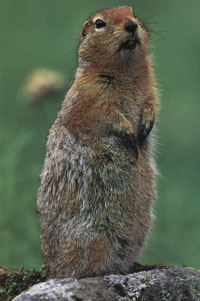

Genus:
Spermophilus
Species: paryii

This ground squirrel might be small but it is very interesting how it is able to survive in the severe elements of the North American tundra. The North American tundra biome is found from 57° to 80° North latitude, and 85° to 160° West longitude. The vegetation in the North American tundra consists of cotton grass, sedge, dwarf heath, and moss. During the summer months the sun shines all day long. The average temperatures in the summer are 3° Celsius to 12° Celsius. During the winter the regular temperatures are &endash;34° Celsius. The only kind of tree that grows in the North American tundra is the dwarf willow.
The arctic ground squirrel's main habitat is the arctic tundra. The squirrels live in the sandy soil for easy digging and good drainage. The arctic ground squirrel's main habitats are on mountain slopes, river flats, banks, lakeshores and tundra ridges.
The arctic ground squirrel's over all length is 1-1.3 feet long and the tail length is 3-5 inches. Their average weight is 23-28 ounces. The arctic ground squirrel is oval shaped. The color of the arctic ground squirrel's coat is gray, spotted with white and is light brown with touches of cinnamon. The head is shaped like an oval and the eyes are oval shaped also. The ears are small and the muzzle is very flat. The legs of the arctic ground squirrels are stubby and they have four toes. The arctic ground squirrel walks on all four legs.
The sexual maturity of an arctic ground squirrel is eleven months. Arctic ground squirrel mating season starts in April and goes to May. The gestation period is 23-31 days and there are five to ten young. The birth weight of an arctic ground squirrel is 1 ounce. The young are blind and hairless for a period of time. The young cannot get their own food so their mothers provide milk for them. An arctic ground squirrel's newborn has no hair and its eyes don't open for twenty days. Only one of the parents raises the young. The mothers move their offspring to at least four different natal burrows to protect them. Closely related mothers will gather their young after they leave their natal burrows for extra protection. The arctic ground squirrel is dependent on its parent for six weeks. The birth interval of an arctic ground squirrel is one year. Arctic ground squirrels are social animals. Groups of arctic ground squirrels are called colonies and a male leads the group. Arctic ground squirrels do not migrate but males will some times immigrate to different colonies. The life span of males is six years and the life span of females is eleven years. Arctic ground squirrels are diurnal creatures.
Arctic ground squirrels are omnivores with a typical diet of seeds, leaves, stems, roots, flowers, and fruit; they also eat insects, small vertebrates and carrion. Arctic ground squirrels are opportunistic feeders so if they are starving they will eat almost anything, if necessary.
The arctic ground squirrels predators are grizzly bears, hawks, owls, falcons, eagles and ermine. They benefit from the tundra environment of tall grass meadows because their small size, and the color of their fur allows them to hide. Another benefit of the tundra vegetation allows them to store enough seeds, grasses, leaves, etc. to survive the harsh winters. Finally the lack of trees allows them to spot predators and alarm the colony.
To minimize detection the arctic ground squirrel will do something called the "tundra glide"; where it presses its body against the ground. Arctic ground squirrels have different warning calls for different ways they are being attacked, such as from the sky or from the land. Arctic ground squirrels have strong claws so they can dig tunnels. The arctic ground squirrel gains a grayer and thicker coat before enduring the coldness of hibernation.
The arctic ground squirrel are not endangered because they don't have much economic value and are still in balance with their predators. Arctic ground squirrels aren't hunted that much by humans compared to how much they used to be. The arctic ground squirrel could evolve into the perfect creature to live in the North American tundra considering all of their adaptations.
by Ben Hopkins
bibliography:
Adams, Clark E. "Ground Squirrels." World Book. 2002 ed.
Whitaker Jr., John. National Audubon Society Field Guide to North American Mammals. Alfred A. Knopf: New York, 1996.
"Arctic Ground
Squirrel"
http://www.nhptv.org/natureworks/arcticgroundsquirrel.html
(12/31/02).
Brensike, Julie
"Spermophilus parryii"
http://animaldiversiy.ummz.edu/accounts/spermophilus/
s._parryiinarrative.html
(12/27/02).
Profile artic Ground Squirrel. International: Masters Publishers, 1998.
"Tundra: The Not So
Barren Land
http://www.ucmp.berkeley.edu/glossary/glos5/biome/tundra.html#arctic
(2/9/03).
"Yukon Mammal Series
artic Ground Squirrel"
http://www.renres.gov.yk.ca/wildlife/agsquirrel.html
(2/8/03).